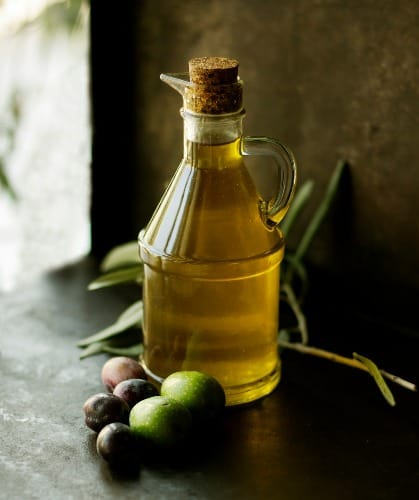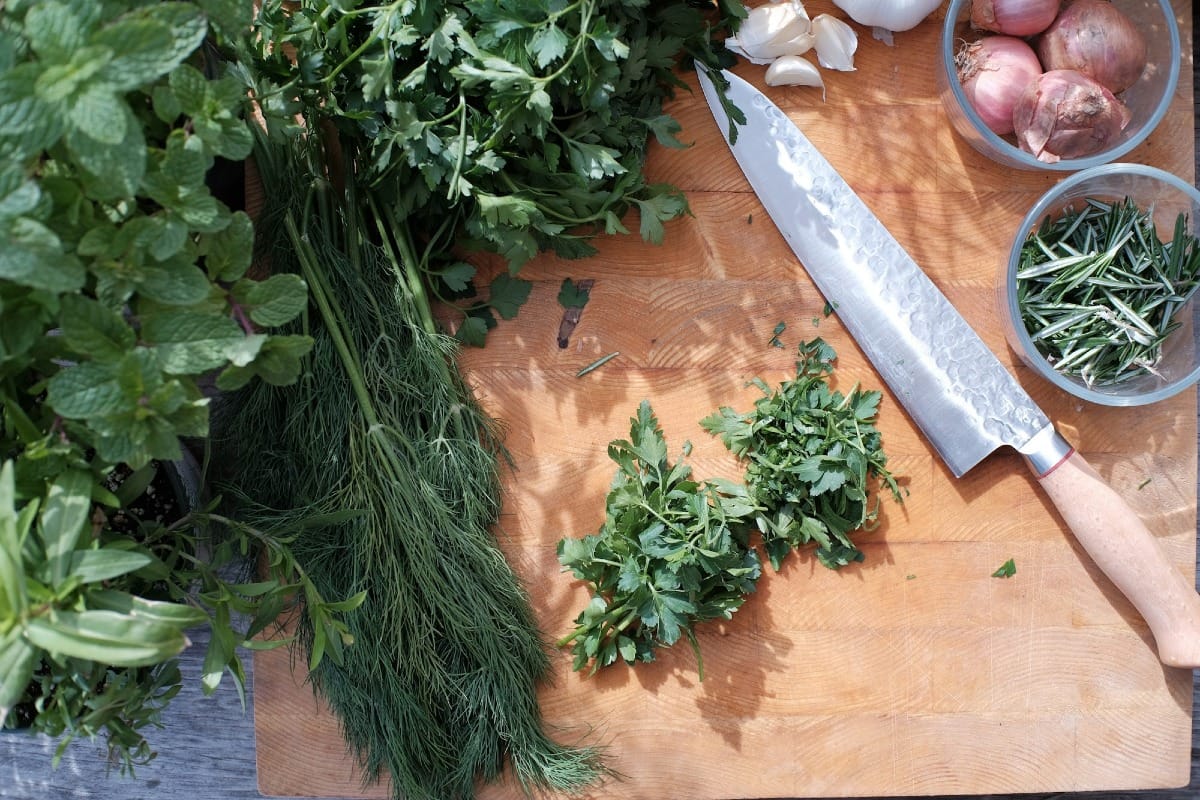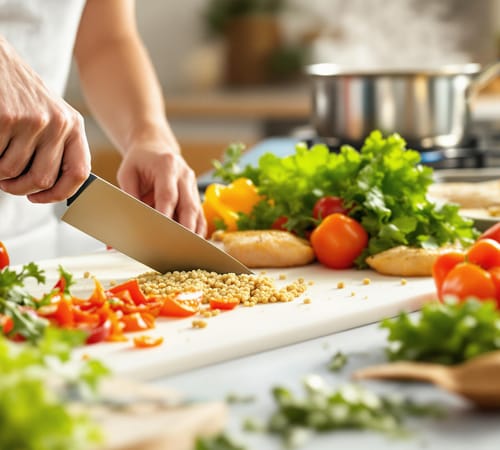Cooking can sometimes feel overwhelming, especially when you're trying to create delicious meals while using fewer ingredients or less oil. Many home chefs face common pitfalls that can lead to unappealing dishes. In this article, we’ll explore some tips and tricks to avoid those mistakes, ensuring you can create flavorful meals without compromising on taste or nutrition.
What Are the Common Mistakes When You Roast Vegetables?
Roasting vegetables is a fantastic way to enhance their natural flavors, yet many home chefs make simple mistakes that diminish their results. One common error is overcrowding the roasting pan, which leads to steaming instead of roasting. This means your vegetables won't get that beautiful caramelization. Simply put, give your veggies some space! Another mistake is not preheating the oven, which can result in uneven cooking. The right cooking method is vital; a hot oven helps achieve the best-roasted vegetables with that delightful texture and depth of flavor.
Another issue that many passionate cooks face is using the wrong temperature. For optimal results, roast your vegetables at high temperatures, typically around 425°F. This allows for a quicker roasting process, ensuring they caramelize beautifully without drying out. And let’s not forget about seasoning! A simple pinch of salt and pepper can transform your veggies, so don’t skimp on it! The goal is to achieve a balance where the natural sweetness of the vegetables shines through, complemented by the right seasoning.
How to Achieve the Best Roasted Vegetables?
To achieve the best roasted vegetables, start by selecting fresh vegetables. The quality of your ingredients significantly impacts the final dish. Cut them into uniform sizes to ensure even cooking, and toss them with a little olive oil and salt. This combination is essential for enhancing the natural flavors while keeping the dish gluten-free. Remember, a little oil goes a long way, so you don’t need to drown your veggies; just a light coating will do the trick. Additionally, consider adding fresh herbs for an extra layer of flavor. Herbs like rosemary, thyme, or oregano can elevate your roasted vegetables to new heights.
Another critical point is to keep an eye on the cooking time. Each vegetable has a different roasting time, so it’s essential to check them periodically. For instance, Brussels sprouts may take about 20-30 minutes, while softer vegetables like zucchini might only need 15-20 minutes. You want to remove them from the oven when they are tender and slightly browned. This not only brings out the best flavor but also leaves you with a beautifully presented dish that’s sure to impress your family or guests.
What Seasoning Works Best for Roasting?
The right seasoning can make or break your roasted vegetables, so it’s essential to choose wisely. A mix of herbs and spices can elevate the dish significantly. Consider using garlic powder, paprika, or even cumin for a unique twist. Fresh herbs are also a fantastic option; they add a burst of flavor and a touch of freshness. A simple blend of olive oil, a pinch of salt and pepper, and your favorite herbs can create a mouthwatering combination that enhances the natural sweetness of the vegetables.
Another idea is to experiment with different seasoning blends. For instance, Italian seasoning or a dash of curry powder can transform the flavor profile of your dish. Just remember that when you’re roasting, you want to achieve a balance that doesn’t overwhelm the natural taste of the vegetables. The key is to keep it simple; sometimes just a drizzle of lemon juice after roasting can brighten the entire dish, giving it that vibrant touch that will have everyone asking for seconds.
How to Avoid Overcooking Brussels Sprouts?
Brussels sprouts can be tricky to get just right, but with a few tips, you can avoid the common mistake of overcooking them. First, opt for fresh Brussels sprouts rather than frozen ones, as they tend to have a better texture and flavor. When preparing them, cut them in half to ensure they cook evenly. Roasting them at a high temperature allows for that crispy outer layer while keeping the inside tender. Keep an eye on them; usually, 20-25 minutes is all they need at 425°F.
Another tip is to toss them in a little olive oil and season with salt and pepper before roasting. Adding a splash of balsamic vinegar can also provide a delightful sweetness that complements their natural taste. Finally, avoid overcrowding the pan, as this leads to steaming rather than roasting. By giving them enough space, you’ll achieve those perfectly roasted Brussels sprouts that are crispy on the outside and tender on the inside. Trust me, your family will love them!

How Can I Create a Delicious Sauce with Less Oil?
Creating a delicious sauce with less oil is entirely possible, and it starts with understanding the basics of sauce-making. A great sauce can enhance any dish, and you don't need to rely on oil for flavor. Instead, focus on using a variety of whole food ingredients. For instance, blending vegetables like tomatoes, onions, and bell peppers can create a rich base for your sauce without the need for excessive oil. Adding a splash of vegetable broth can also help achieve the desired consistency while keeping it healthy.
Additionally, incorporating spices and seasonings will elevate the taste of your sauce. Think about fresh herbs, garlic, or even a pinch of chili flakes for some heat. You can also use acidic ingredients like vinegar or lemon juice to brighten up the flavors without adding oil. Simply put, with the right combination of ingredients, you can make a sauce that is both delicious and nutritious.
What Ingredients Make a Healthy Sauce?
When aiming for a healthy sauce, it’s essential to focus on using fresh ingredients that pack a punch in terms of flavor. Start with a base of fresh tomatoes or roasted red peppers, which can add natural sweetness and depth. You can also incorporate ingredients like garlic, onion, and fresh herbs, which not only enhance the taste but also provide various health benefits. Using a little bit of vinegar or lemon juice can add acidity, balancing the flavors without needing excess oil.
Another great addition is legumes, such as chickpeas or lentils, which can create a creamy texture when blended into your sauce. This method is particularly effective if you’re looking to minimize oil while still achieving a rich consistency. By combining these ingredients, you’ll create a sauce that’s not only healthy but also packed with flavor, making it a perfect complement to any dish.

How to Use Fresh Herbs for Flavor?
Fresh herbs are a game-changer when it comes to adding flavor to your dishes without relying on heavy oils or fats. They can transform a simple sauce or dish into a culinary masterpiece. Start by chopping fresh herbs such as basil, parsley, or cilantro, and sprinkle them into your sauces or roasted vegetables just before serving. This not only adds a burst of flavor but also enhances the presentation of your dish.
Another idea is to create herb-infused oils by blending fresh herbs with a little olive oil, allowing the flavors to meld together beautifully. These oils can be drizzled over salads, vegetables, or even used as a dipping sauce for bread. When cooking, consider adding herbs early on to build flavor, then finishing with fresh herbs for a vibrant taste. Simply put, utilizing fresh herbs is an easy and effective way to elevate your cooking while keeping it healthy and delicious.
What Are the Best Tips for Sautéing with Minimal Fat?
Sautéing with minimal fat is an excellent way to keep your meals healthy while still delivering great flavor. The key is to use the right cooking method, starting with a well-heated pan. This allows you to sauté vegetables quickly, preserving their nutrients and texture without needing a lot of oil. Using a non-stick skillet can also help minimize the amount of fat you need, making it easier to achieve that lovely golden color without burning.
Another great trick is to incorporate broth or water into the sautéing process. This helps to create steam, allowing your vegetables to cook through while keeping them moist and flavorful. For added depth, try adding a splash of soy sauce or balsamic vinegar instead of oil. These alternatives not only provide flavor but also reduce the overall fat content of your dish, making your meal healthier without sacrificing taste.
How to Sauté Vegetables Without Burning Them?
Sautéing vegetables without burning them requires attention and the right techniques. Start by preheating your pan and adding just a little oil to coat the bottom. Be sure to cut your vegetables into even pieces so they cook at the same rate. If you’re using high heat, stir frequently to prevent them from sticking or burning. Remember, the goal is to achieve that lovely caramelization without crossing the line into burnt territory.
Another tip is to work in batches if you have a large quantity of vegetables. Overcrowding the pan can lead to steaming instead of sautéing, resulting in soggy veggies. If you notice the pan becoming too dry, add a splash of water or broth to keep things moving along. This will not only prevent burning but also infuse your vegetables with extra flavor. With these tips, you’ll master the art of sautéing without a hitch!
What Cooking Methods Minimize Saturated Fat?
Minimizing saturated fat in your meals can be achieved through various cooking methods that emphasize healthy techniques. Steaming, grilling, and roasting are excellent choices that not only enhance flavor but also preserve nutrients. When you steam vegetables, for instance, you avoid the need for excessive oil while maintaining their vibrant color and crunch. Grilling is another fantastic option, as the fat drips away from the food while it cooks, leaving you with a healthier dish.
Additionally, consider using a food processor for meal prep. This tool can help you chop vegetables quickly, making it easier to incorporate them into your meals without the need for added fats. When you do use oil, try to stick to healthy fats like olive oil and use them sparingly. By focusing on these cooking methods, you can create satisfying meals that are both delicious and low in saturated fat.
How Can I Use a Food Processor for Sautéing?
Using a food processor for sautéing may seem unconventional, but it can revolutionize your cooking process. First, chop your vegetables in the food processor to ensure uniformity. This not only saves time but allows for even cooking when sautéing. Once your vegetables are ready, heat a pan with a little olive oil, then add your pre-chopped veggies. The even sizes will help them cook perfectly, reducing the risk of burning.
Another great use for a food processor is to create sauces and dips that can accompany your sautéed dishes. Blend fresh herbs, garlic, and a splash of lemon juice for a quick and healthy sauce. Drizzle this over your sautéed vegetables for an extra layer of flavor that enhances the overall dish. This method not only minimizes the use of saturated fats but also encourages you to use fresh ingredients, making for a deliciously healthy meal.
How to Prepare a Healthy Salad Dressing?
Preparing a healthy salad dressing doesn’t have to be complicated. In fact, making your own vinaigrette is a simple and effective way to control the ingredients and flavors. Start with a base of three parts oil to one part vinegar; this creates a balanced dressing that isn’t overly oily. You can use olive oil, avocado oil, or even nut oils for a unique flavor. To this base, add a pinch of salt and pepper, along with your choice of fresh herbs or spices for added taste.
Don’t forget about incorporating additional ingredients like mustard or honey for a bit of sweetness and tang. Whisk everything together until it’s well blended, and you’ll have a delicious dressing that elevates any salad. When making dressings at home, you control the flavors and can experiment with different combinations, ensuring you always have a healthy option at your fingertips.

What Are the Key Ingredients for a Vinaigrette?
When crafting a vinaigrette, the key ingredients are quite simple but essential for achieving that perfect balance of flavor. Start with a high-quality oil, such as extra virgin olive oil, which provides a rich flavor base. Pair this with vinegar of your choice—balsamic, red wine, or apple cider vinegar are popular options. The ratio is typically three parts oil to one part vinegar; however, you can adjust this based on your taste preference. Adding a pinch of salt and pepper enhances the overall flavor and brings the ingredients together.
For an extra layer of complexity, consider including additional flavor agents like Dijon mustard, honey, or fresh herbs. These additions can elevate your vinaigrette, making it unique and tailored to your palate. Simply whisk all these ingredients together, and you’ll have a vibrant dressing that complements any salad or dish beautifully. With these basic principles, you’ll never have to settle for store-bought options again!
How to Make Tahini Dressing for a Kale Salad?
Making tahini dressing for a kale salad is a fantastic way to add creaminess without relying on heavy oils or dairy. Start with a base of tahini, which is made from ground sesame seeds and provides a rich, nutty flavor. To prepare the dressing, simply whisk together tahini with water, lemon juice, a pinch of salt, and a clove of minced garlic. This combination creates a creamy texture that perfectly coats the kale.
When preparing your kale salad, massage the dressing into the kale leaves to help soften them and make them more palatable. This technique enhances the flavor and ensures every bite is delicious. For added crunch, consider topping your salad with roasted chickpeas or nuts for a nutritious boost. This tahini dressing not only adds flavor but also packs a punch of healthy fats and proteins, making your kale salad a satisfying meal.
How to Cook with Less While Still Making Kids Eat Healthy?
Cooking with less while ensuring your kids eat healthy can seem like a daunting task, but it’s entirely feasible with a few simple strategies. Focus on incorporating whole foods that are naturally nutritious and appealing to children. For instance, using simple recipes like veggie-packed quesadillas or colorful stir-fries can make vegetables more enticing. Get creative with presentation; arranging foods in fun shapes or using vibrant colors can spark kids' interest and encourage them to try new things.
Another effective approach is to involve your kids in the cooking process. When they help prepare meals, they are often more willing to try what they’ve made. Encourage them to choose vegetables at the grocery store or to help mix ingredients in the kitchen. This engagement makes them feel invested in their meals, increasing the likelihood that they’ll eat healthy options. With a bit of creativity, you can make nutritious eating fun and enjoyable for your kids!
What Simple Recipes Can Encourage Kids to Eat Vegetables?
Creating simple recipes that encourage kids to eat vegetables can be a game-changer. One great idea is to make vegetable skewers; let your kids choose their favorite vegetables, and then grill or roast them for a colorful and fun meal. Another option is to whip up a batch of homemade vegetable soup. Incorporate a variety of fresh vegetables and let your kids help with chopping and stirring. The warmth and flavor of the soup can make veggies feel more comforting and appealing.
Consider also making smoothies packed with leafy greens like spinach or kale, blended with fruits like bananas and berries. The sweetness of the fruit masks the taste of the greens, making it a hit with kids. By keeping recipes simple and allowing for their input, you can create an enjoyable cooking experience that encourages healthy eating habits.
How to Use Chickpeas in Family Meals?
Chickpeas are a versatile ingredient that can easily be incorporated into family meals, making them a great option for healthy eating. One simple way to use chickpeas is to create a delicious hummus dip. Blend chickpeas with tahini, garlic, lemon juice, and a touch of olive oil for a creamy, nutritious dip that pairs perfectly with fresh veggies or whole-grain pita. This not only adds flavor but also provides a boost of protein, making it a satisfying snack.
Another idea is to add chickpeas to salads or grain bowls. They can add a hearty texture and flavor, making your meal more filling. Roasting chickpeas with spices can create a crunchy topping for soups or salads, providing a delightful crunch. With their mild flavor and adaptability, chickpeas can easily be a staple in your family meals.
What Are Some Tips and Tricks for Flavorful Cooking?
Flavorful cooking doesn’t have to be complicated; with a few tips and tricks, you can elevate any dish. Start by using fresh ingredients; they make a world of difference in taste. Don’t be afraid to experiment with herbs and spices; a pinch of salt and pepper can enhance flavors, but adding garlic, cumin, or paprika can take your dish to the next level. Also, consider using acid, like lemon juice or vinegar, to brighten up your meals—this small addition can really make flavors pop.
Another great tip is to build layers of flavor throughout the cooking process. Sautéing onions and garlic at the beginning creates a delicious base for sauces and soups. Finally, don’t overlook the importance of presentation. A well-plated dish not only looks appetizing but can also make the food more enjoyable to eat. With these simple strategies, you’ll be well on your way to creating delicious, flavorful meals that everyone will love!




